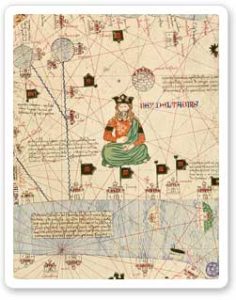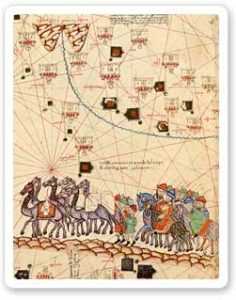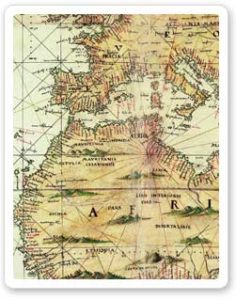On February 2nd, 1876 the Sociedad Geográfica de Madrid was created in a ceremony held at the Real Academia de la Historia, chaired by the then-Ministry of Works, Francisco de Borja y Queipo de Llano. Relevant personalities and professionals of the time were present.
The first Board of Directors was chaired by the exminister and former major of Madrid, Fermín Caballero, who had been the first professor of Geography in the Universidad Central. He was aged and died very soon. The Presidency fell then on the geographer and famous military cartographer, Francisco Coello de Portugal y Quesada, one of the society’s promoters. Many public and scientific personalities were members of this first Society; among them, there were politicians such as Antonio Cánovas or Segismundo Moret, military cartographers such as Carlos Ibáñez de Ibero, the founder of the Instituto Geográfico Nacional, engineers such as Carlos María de Castro, the planner and promoter of the Ensanche (residential and urban development) in Madrid and, in general, many other distinguished figures of the Spain of the Restoration, such as Joaquín Costa, José Echegaray, Cesáreo Fernández Duro, etc.
In 1901, at the proposal of the Ministry for Public Education and by Royal Order dated February 18th, the Society became the Real Sociedad Geográfica, of which the King was a Patron and His Royal Highness Don Carlos de Borbón a Honorary President. Geography, riding between the two centuries, was a strategical knowledge basic for inter-States relations and even for the inner policy of each nation. Colonial expansion, national unifications, industrial imperialism and even any infrastructural and developmental works gave to land knowledge and interpretation an outstanding political relevance, founded on an increasing scientific and academic interest for projects of land expansion both in Africa and Asia, as is the case of Colonial Geography, and for the development of the metropolis, as in the case of Political Geography and of Geopolitics.
The Real Sociedad Geográfica started its activities immersed in this political and scientific climate, and therefore it reported and welcomed land discovering and annexing actions, such as those of Iradier, in Guinea, and those by Joaquín Gatell (also known as Kaid Ismail), Emilio Bonelli and José Álvarez Pérez in Morocco and Sahara, the early precedents for the later intervention of Spain in Africa, and also that by Abargués de Sostén in Eastern Africa. These exploration and discovery enterprises shared the attention of the Sociedad with exclusively scientific and academic activities, which where recorded in the Boletín and in many other publications. Among them, the most outstanding contributions are by some members, such as Blázquez or Saavedra on Historical Geography and Geographical History, or by Joaquín Costa and Lucas Mallada on Spanish nature and regeneration.
Another chapter was the collaboration and merging with other societies and scientific and exploration associations, such as Sociedad Española para la Exploración de África (1877) and Sociedad Española de Africanistas y Colonialistas (1833), that became later the Sociedad de Geografía Comercial (1885), all of which were absorbed by the Sociedad Geográfica. Another activity was the organisation of scientific meetings, such as the Congreso Español de Geografía Colonial y Mercantil (1883) and the congress held in 1892, related to the Fourth Centenary of the Discovery of America, Congreso Geográfico Hispano Portugués Americano. This event took place in Madrid and a good representation of the Geographical Societies of the American Continent gathered there; their tacit objective was to create an international association of Hispanic Geographical Societies, objective that was not met. Two other later History and Geography Hispanic-American congresses that took place in Seville in 1914 and 1921, also had the Real Sociedad Geográfica among their sponsors.
In 1922, the International Geographical Union was created in Brussels; the Real Sociedad Geográfica was one of the seven state representations that promoted the event. That same year, the Board of Directors became, under order dated December 26th, 1922, the Spanish National Committee of the International Geographical Union. Since then, the RSG has participated in the international meetings organised by the IGU. Thus, in 1986, it helped to organized the Regional Conference of Mediterranean Countries, held in Barcelona. In 1996 it promoted the renewal of the National Committee and opened it to other geographical institutions and societies, in concrete the Asociación de Geógrafos Españoles. According to its Statutes, the Real Sociedad Geográfica’s objective is to «promote geographical knowledge progress and disemination in all its branches and applications to social, political and economic life» devoting «preferently its studies to the Spanish lands and those of the peoples linked to Spain by language and other reasons».
Joaquín Bosque Maurel
Of Real Sociedad Geográfica.
For more information on the history of RSG see the following article:
Bosque Maurel, J (2004): La Real Sociedad Geográfica 125 años de existencia, en García, Martín, Méndez, Riera y Valenzuela (eds), (2004).»La Geografía Española ante los retos de la sociedad actual». Aportación Española al XXIX Congreso de la Unión Geográfica Internacional.Glasgow 2004. Comité Español de la UGI. Madrid.



